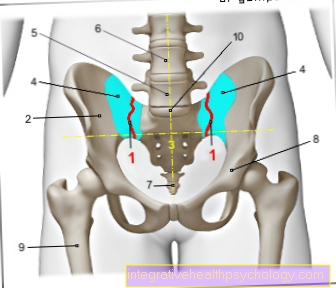Operation of a ptosis
introduction
If there is severe age-related or congenital ptosis, surgery of the affected eyelid is indicated. However, if the ptosis is caused by paralysis or muscle weakness, usually no intervention should be performed. Alternatively, in these cases, bar glasses can be fitted to pull the upper eyelid upwards.
The operation is performed under local or general anesthesia. The upper eyelid is raised by the surgical techniques so that the eyelid gap is functionally expanded and the ptosis is thus eliminated. Depending on the findings, the most suitable technique can be selected from several options, which is best suited for use in individual ptosis.

General
If there is mild ptosis, a portion of the rear upper eyelid area is cut and the edges of the incision are sutured so that the lid is tightened (Operation according to Fasanella Servat).
To treat ptosis, a piece of the eyelid elevator muscle (between 10 and 22 millimeters depending on the severity) is often removed, the so-called levator resection. Surgical folding of the muscle is also possible in order to achieve a shortening.
In the case of severe ptosis or insufficient muscle strength of the eyelid lifter, surgical suspension on the forehead muscle is also conceivable (Frontalis suspension). After the operation, the patient is able to pull up the lid by moving the frontal muscle.
Possible complications
Often there are bruises and swellings, but these usually resolve quite quickly on their own.
- Bleeding
- Nerve injuries
- Infections
- Wound healing disorders
- as well as scars are possible.
Structural damage to the eye itself rarely occurs. Often, the effect is too weak after the operation (Undercorrection), so that ptosis is still present. Every now and then the opposite is the case, so that the lid is pulled up too much. This can lead to a lack of eyelid closure, so that the eye can dry out and a corneal ulcer is possible. Another operation is partly possible.
Behavior after the operation
The patient should avoid physical activity shortly after the operation and in the days after it. When washing, the respective eyelid should be spared and the operating area should generally be spared.
The stitches will be removed by the doctor after a few days. As soon as complications arise or an under or over correction is noticed, the doctor should be informed quickly so that extensive corneal damage can be avoided.
When will the operation be covered by the health insurance?
The operation for ptosis is usually covered by the health insurance company if there is a medical indication. Medical indications can be restrictions of the visual field, frequent inflammation of the conjunctiva, irritation of the cornea or eyelid misalignments after accidents or injuries. It is always advisable to consult with the health insurance company whether the costs will be covered.
If the operation only has a cosmetic benefit, you have to pay the costs yourself.
If the ptosis is congenital, an operation is usually also covered by the health insurance to prevent the risk of permanent lifelong weak vision (amblyopia).
What are the costs for the operation?
The cost of an operation for ptosis varies between 1700 and 5000 euros. Depending on the clinic, surgical procedure and aftercare, the costs can vary widely.
When should I have the operation performed on a child?
There is no one-size-fits-all answer to when a child with ptosis should be operated on. It is advisable to decide with the attending physician when an operation makes sense.
In children there is a risk of permanent lifelong weak vision (amblyopia) if the drooping lid restricts the field of vision, as the eye continues to develop years after birth. The drooping lid restricts this development and thus the ability to see.
Surgery is usually recommended at 3-4 years of age. If the findings are pronounced, an operation can also be performed earlier.





























